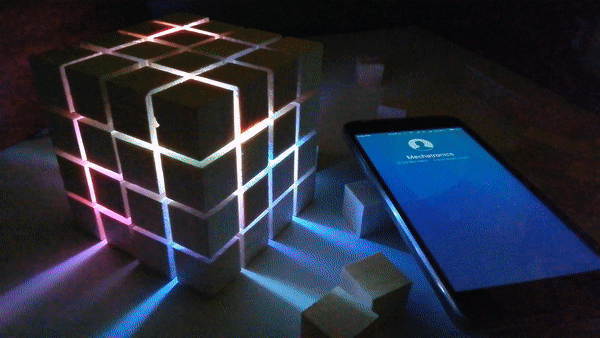

Introduction
Today we are going to make


Hardware required
| Components | Amazon.in | Amazon.com | Banggood | AliExpress |
| Arduino Nano | ||||
| Addressable WS2811 5v | ||||
| Mic based Sound Sensor Module | ||||
| White Wood Cube |
Theory
The sounds will be picked by the mic module and will be amplified and fed to the Arduino analog pin, we will read the analog pin values and using the fastLED library we will change the colors of the LEDs randomly according to the received values from the mic.
Construction




















Finished Product Photos
Schematics


| Arduino | Mic module | Addressable WS2811 |
| 5V | VCC | VCC |
| A5 | OUT | |
| GND | GND | GND |
| D5 | IN |
Programming
Installing Library. Click to expand (for beginners)
The only library which we have used for this project is fastLed library, we can download and install it from their Github page https://github.com/FastLED/FastLED.
Step 1:
Download the library from https://github.com/FastLED/FastLED
  |
| Download ZIP |
Step 2:
Go to the Sketch menu in Arduino IDE from there select -> Include Library -> Add.ZIP Libray and Choose the downloaded library file from your download folder.
Test Video
Video Tutorial
Code
#include "FastLED.h" //fast led library
#define NUM_LEDS 10 //total no. of leds used
#define DATA_PIN 5 //digital pin at which the data pin is connected
#define mic A5 //analog input from mic module
int mic_Value; //to save raw value from mic
int red, green, blue; //to store RGB color values
CRGB leds[NUM_LEDS]; //fast led function
void setup() {
FastLED.addLeds<UCS1903B, DATA_PIN, RGB>(leds, NUM_LEDS); //as our led IC is UCS1903B,fast led support lots of ICs, find more
//FastLED.addLeds<WS2812B, DATA_PIN, RGB>(leds, NUM_LEDS); //if you are using WS2812B insted of UCS1903B
LEDS.setBrightness(200); //setting brightness of LED (0 to 255) //info at fastled.io
randomSeed(analogRead(0));// for generating random no. by taking noise from analog pin 0
for (int i = 0; i <= 9; i++) //for changing color of all 10 LEDs
{
leds[i] = CRGB(200, 200, 200); //for initial white color
LEDS.show(); //fastled function, without this function the colors won't be updated
}
}
void loop() {
mic_Value = analogRead(mic); //storing analog values from mic to mic_value
if(mic_Value>100) //to avoid small noise
{
for(int i=0;i<=9;i++)//for changing color of all 10 LEDs
{
red=random(255); //random red color value between 0 to 255
green=random(255); //random green color value between 0 to 255
blue=random(255); //random blue color value between 0 to 255
leds[i]=CRGB(red,green,blue); //assigning color values to LEDs
LEDS.show();
}
}
}








Great job yaar ��
thank you
Instead of showing the schematics can you take a picture of how you arranged the wires? Bbecause as a student it is quite hard to understand.